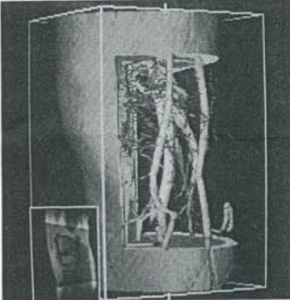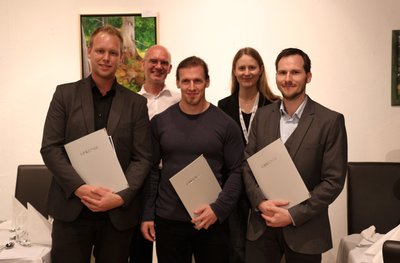As medvis professionals, we are accustomed to volume rendering as an every-day tool for exploration of medical data. The two technical papers below represent one of the first milestones in rendering volumetric data. We are extremely happy and excited that Professor Karl Heinz Höhne allowed us to post these papers on our blog. Published in 1986 and 1988, these papers cannot be found online anywhere else and proposed groundbreaking volume rendering techniques.

Combined 3D-display of conventional and angiographics MR data.
The first paper entitled ‘Shading 3D-images from CT Using Gray-Level gradients’ by Karl Heinz Höhne and Ralph Bernstein was published in 1986 in the IEEE Transactions on Medical Imaging. This paper describes a shading method based on the partial volume effect using the gray-level gradients along a surface reconstruction of CT images. What sets this method apart from current gradient vector computations is that the gray-values are sampled in screen space and not in voxel space. As a result, surfaces perpendicular to the viewer are brighter than surfaces oriented away from the viewer. In essence, this shading method simulates a headlight configuration.
The second paper entitled ‘Display of Multiple 3D-Objects Using the Generalized Voxel-Model’ by Karl Heinz Höhne, Michael Bomans, Ulf Tiede and Martin Riemer was published in 1988 in the SPIE proceedings. In this paper a generalized voxel-model for the generation of 3D-views from MR-volume data is proposed.
Using the software and hardware that was available at the time, these papers represent many contributions to the field, for instance selective volume clipping and multimodal visualization. With their work, they created a solid foundation for state-of-the-art (medical) volume rendering techniques. The two papers usually credited as first presenting the ideas behind raycasting, both published in 1988, are:
- R. A. Drebin, L. Carpenter, and P. Hanrahan, “Volume rendering,” SIGGRAPH Comput. Graph., vol. 22, no. 4, pp. 65–74, Aug. 1988.
- M. Levoy, “Display of surfaces from volume data,” IEEE Computer Graphics and Applications, vol. 8, no. 3, pp. 29-37, May 1988.




